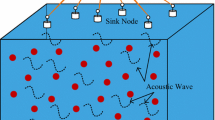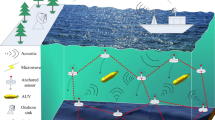Abstract
With the advance and wide applicability of the Internet of Underwater Things, smart things are deployed under the water and form the underwater wireless sensor networks, for the exploration of vast ocean volume. Generally, a sub-region, rather than the whole network region, may be interested by a certain application in a certain time duration. To address this challenge, a sub-region query processing mechanism is proposed. Specifically, a routing tree is constructed where a sensor node corresponds to a tree node. A sensor node acknowledges the fact that whether it lies within the sub-region of interest or not through the localisation techniques. Sensory data are routed to the sink node leveraging the parent–child relation of sensor nodes specified in the routing tree. Experimental evaluation shows that our technique is more energy efficient when the network topology is relatively steady.









Similar content being viewed by others
References
Fang S, Xu LD, Zhu Y, Ahati J, Pei H, Yan J, Liu Z (2014) An integrated system for regional environmental monitoring and management based on internet of things. IEEE Trans Industr Inform 10(2):1596–1605
Ayaz M, Baig I, Abdullah A, Ibrahima Faye (2011) A survey on routing techniques in underwater wireless sensor networks. J Netw Comput Appl 34(6):1908–1927
Lee ML, Dey AK (2015) Sensor-based observations of daily living for aging in place. Pers Ubiquit Comput 19(1):27–43
Zuba M (2014) Connecting with oceans using underwater acoustic networks. XRDS 20(3):32–37
Domingo MC (2012) An overview of the internet of underwater things. J Netw Comput Appl 35(6):1879–1890
Xu G, Shen W, Wang X (2014) Applications of wireless sensor networks in marine environment monitoring: a survey. Sensors 14(9):16 932–16 954
Akhlaq M, Sheltami TR, Shakshuki EM (2014) C3: an energy-efficient protocol for coverage, connectivity and communication in wsns. Pers Ubiquit Comput 18(5):1117–1133
Adnan T, Datta S, MacLean S (2014) Efficient and accurate sensor network localization. Pers Ubiquit Comput 18(4):821–833
Han G, Zhang C, Shu L, Rodrigues JJPC (2015) Impacts of deployment strategies on localization performance in underwater acoustic sensor networks. IEEE Trans Industr Electron 62(3):1725–1733
Burguera A, Bonin-Font F, Oliver G (2015) Trajectory-based visual localization in underwater surveying missions. Sensors 15(1):1708–1735
Noh Y, Lee U, Lee S, Wang P, Vieira LFM, Cui J-H, Gerla M, Kim K (2015) Hydrocast: pressure routing for underwater sensor networks. IEEE Trans Veh Technol. doi:10.1109/TVT.2015.2395434
Cho H-H, Chen C-Y, Shih TK, Cha H-C (2014) Survey on underwater delay/disruption tolerant wireless sensor network routing. IET Wireless Sensor Syst 4(3):112–121
Lee S, Kim D (2013) Underwater hybrid routing protocol for UWSNs. In: 5th IEEE international conference on ubiquitous and future networks, pp 472–475
Coutinho RWL, Boukerche A, Vieira LFM, Loureiro AAF (2014) GEDAR: geographic and opportunistic routing protocol with depth adjustment for mobile underwater sensor networks. In: IEEE international conference on communications, pp 251–256
Zhou Z, Yao B, Xing R, Shu L, Bu S (2015) E-CARP: an energy efficient routing protocol for UWSNs in the internet of underwater things. IEEE Sensors J. doi:10.1109/JSEN.2015.2437904
Han G, Jiang J, Shu L, Xu Y, Wang F (2012) Localization algorithms of underwater wireless sensor networks: a survey. Sensors 12(2):2026–2061
Climent S, Sanchez A, Capella JV, Meratnia N, Serrano JJ (2014) Underwater acoustic wireless sensor networks: advances and future trends in physical, MAC and routing layers. Sensors 14(1):795–833
Emokpae LE, DiBenedetto S, Potteiger B, Younis M (2014) Ureal: underwater reflection-enabled acoustic-based localization. IEEE Sens J 14(11):3915–3925
Basagni S, Petrioli C, Petroccia R, Spaccini D (2014) CARP: a channel-aware routing protocol for underwater acoustic wireless networks. Ad Hoc Netw. doi:10.1016/j.adhoc.2014.07.014
Porter MB (2011) The bellhop manual and users guide: preliminary draft. Heat, Light, and Sound Research Inc
Emokpae LE, Younis M (2014) Surface-reflection-based communication and localization in underwater sensor networks. ACM Trans Sensor Netw 10(3):50
Xu M, Liu G (2013) A multi-link fault-tolerant routing protocol for three dimensional underwater acoustic sensor networks. J Comput Inf Syst 9(11):4345–4352
Kim Y, Park S-H (2011) A query result merging scheme for providing energy efficiency in underwater sensor networks. Sensors 11(12):11 833–11 855
Degirmenci G, Kharoufeh JP, Prokopyev OA (2014) Maximizing the lifetime of query-based wireless sensor networks. ACM Trans Sensor Netw 10(4):56
Yan H, Shi ZJ, Cui J-H (2008) DBR: depth-based routing for underwater sensor networks. In: 7th international IFIP-TC6 networking conference on ad hoc and sensor networks, wireless networks, next generation internet, pp 72–86
Noh Y, Lee U, Wang P, Choi BSC, Gerla M (2013) VAPR: void-aware pressure routing for underwater sensor networks. IEEE Trans Mob Comput 12(5):895–908
Ali T, Jung LT, Faye I (2014) End-to-end delay and energy efficient routing protocol for underwater wireless sensor networks. Wireless Pers Commun 79(1):339–361
Xie P, Cui J-H, Lao L (2006) VBF: vector-based forwarding protocol for underwater sensor networks. In: 5th international IFIP-TC6 conference on networking technologies, services, and protocols; performance of computer and communication networks; mobile and wireless communications systems, pp 1216–1221
Nicolaou N, See A, Xie P, Cui J-H, Maggiorini D (2007) Improving the robustness of location-based routing for underwater sensor networks. In: IEEE OCEANS, pp 1485–1490
Jornet JM, Stojanovic M, Zorzi M (2008) Focused beam routing protocol for underwater acoustic networks. In: 3rd ACM international workshop on underwater networks, pp 75–82
Al-Salti F, Alzeidi N, Arafeh B (2014) A new multipath grid-based geographic routing protocol for underwater wireless sensor networks. In: IEEE international conference on cyber-enabled distributed computing and knowledge discovery, pp 331–336
Acknowledgments
This work was supported partially by the National Natural Science Foundation of China (Grant No. 61379126), by the Scientific Research Foundation for Returned Scholars, Ministry of Education of China, and by the Fundamental Research Funds for the Central Universities.
Author information
Authors and Affiliations
Corresponding author
Rights and permissions
About this article
Cite this article
Zhou, Z., Xing, R., Gaaloul, W. et al. A three-dimensional sub-region query processing mechanism in underwater WSNs. Pers Ubiquit Comput 19, 1075–1086 (2015). https://doi.org/10.1007/s00779-015-0875-7
Received:
Accepted:
Published:
Issue Date:
DOI: https://doi.org/10.1007/s00779-015-0875-7




